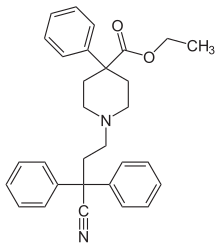Diphenoxylate
 |
|
 |
|
| Clinical data | |
|---|---|
| AHFS/Drugs.com | Monograph |
| Routes of administration |
Oral |
| ATC code | |
| Legal status | |
| Legal status |
|
| Pharmacokinetic data | |
| Protein binding | 74-95% |
| Biological half-life | 12–14 hours |
| Identifiers | |
|
|
| Synonyms | R-1132, NIH-756 |
| CAS Number | |
| PubChem CID | |
| IUPHAR/BPS | |
| DrugBank | |
| ChemSpider | |
| UNII | |
| KEGG | |
| ChEBI | |
| ChEMBL | |
| ECHA InfoCard | 100.011.837 |
| Chemical and physical data | |
| Formula | C30H32N2O2 |
| Molar mass | 452.587 g/mol |
| 3D model (Jmol) | |
|
|
|
|
|
|
|
Diphenoxylate (INN, BAN) (brand name Diocalm), or diphenoxylate hydrochloride (USAN), is a centrally active opioid drug of the phenylpiperidine series that is used for the treatment of diarrhea. It acts by slowing intestinal contractions and peristalsis allowing the body to consolidate intestinal contents and prolong transit time, thus allowing the intestines to draw moisture out of them at a normal or higher rate and therefore stop the formation of loose and liquid stools. It is the main active ingredient in the anti-peristaltic medication Lomotil, which also contains atropine.
Diphenoxylate is the prototype of a small subfamily of opioids (the phenylpiperidines) including difenoxin (diphenoxylic acid), an active metabolite of diphenoxylate produced in the human body, and loperamide, which unlike the former two works exclusively in the intestines because it only crosses the blood–brain barrier in very small amounts. It was discovered at Janssen Pharmaceutica in 1956. It is a congener to the narcotic pethidine. Other somewhat more distant relatives include alphaprodine and piritramide.
Diphenoxylate works by decreasing the speed and amplitude of wave-like movements of the intestines (peristalsis) therefore allowing the body time to remove moisture from the intestinal contents and consolidate waste product into a dense solid form rather than loose and watery as is diarrhea.
...
Wikipedia
